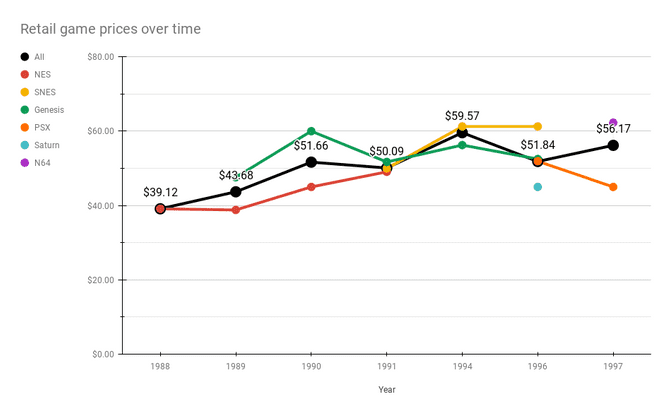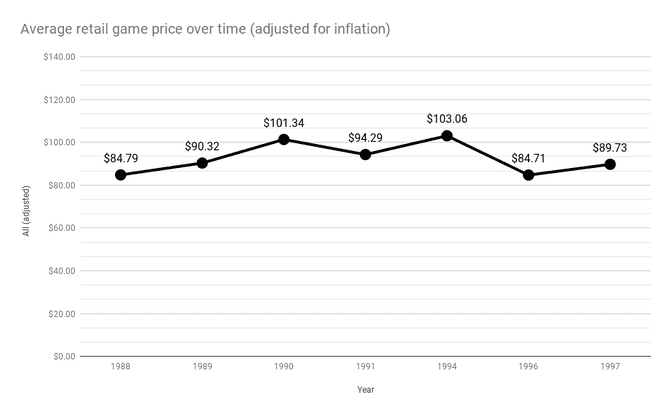whatbrentsay
7/8
Last week 2K Games announced the price of NBA 2K21. This isn't normally worth talking about; gamers haven't needed a price announcement for any AAA game for the last 15 years. Games have been $59.99 at retail and that was that. What made 2K Games' announcement newsworthy is their pricing for NBA 2K21 on PlayStation 5 and Xbox Series X: it'll be $69.99.
I wasn't expecting a price increase this gen. I'm not surprised, but I wasn't expecting it. Objectively, it's odd for a consumer product to keep a constant price for over 15 years without adjusting for inflation. Gamers who spent $59.99 on a Xbox 360 launch title in 2005 spent $78.76 in 2020 money. That's not even that long ago and AAA games cost a lot more money to make now than they did in 2005.
A price adjustment makes sense; it's overdue. What's nagging me is how unfortunate the timing is. If we remember this waning console generation for anything, it'll be for the popularization of the live service game. We'll also remember just how many live service games released in a state you couldn't honestly call finished. Why did we see so many of these games and why were so many of them subpar at release? Well, they make a boatload of money, regardless of how polished or critically acclaimed they are. Studios pushed the boundary—essentially racing to the bottom—and gamers eventually drew the line at titles like Star Wars Battlefront II, Anthem, NBA 2K19, and Ghost Recon Breakpoint (among others).
It's on the back of those shitshows that game prices are going up. To add salt to the wound, the company that's preparing gamers for this new world has been egregiously utilizing micro-transactions for years now. It sure adds some insult to injury. Is the cost justified when so much money is made after the game is purchased? It's nearly impossible to get granular numbers but 2K Games reported "recurrent consumer spending" was up 34% year over year, making for 51% of total net bookings in their last fiscal year. Food for thought.
On the bright side, even with a $70 price tag, gamers aren't forging into completely unknown territory. Games have hit that price point at retail further back than you might know, expect, or remember. I certainly didn't and I played a lot of them. While researching for this post, I came across a collection of old holiday catalogs from SEARS, JC Penny, Electronics Boutique, and other hobby shops. I went through the ones I could find between the years of 1988 and 1997, jotting down the prices of games that caught my eye along the way. Truthfully, it was a non-scientific indulgence of nostalgia—these old consoles were my childhood!—but I came away with a few worthwhile insights.
First off, here's a few titles that were listed for over $60 at retail.
The $70 spent on Phantasy Star II in 1990 is ~$137 in 2020 money. Would you even consider spending that much on a game that isn't a limited or special edition?
Overall, I captured 108 games. Here's what the average price looked like during those years.
You can get a sense of where consoles-specific games fell above and below that line.
Secondly—and hopefully this makes you feel a little better—when you adjust for inflation, the price of games is much lower now than it was in the 90s. Here's the yearly average from the above chart adjusted for inflation.
A little perspective goes a long way. Do I want to spend $70 on a base AAA game in 2020? Nope. Am I glad I'm not spending $85+ on the same title? You bet. What I hope is that the completeness and quality of next-gen titles is deserving of that extra $10. I don't think that's too much to ask for.
Related reading and resources that helped me write this:
Here's a Sheet with my raw data, if you're into that kind of thing
Take-Two hits record financials, with in-game revenues up 34%
“Do Games Cost Too Much?”: An Analysis of Modern & Historical Video Game Prices
Why retail console games have never been cheaper, historically


